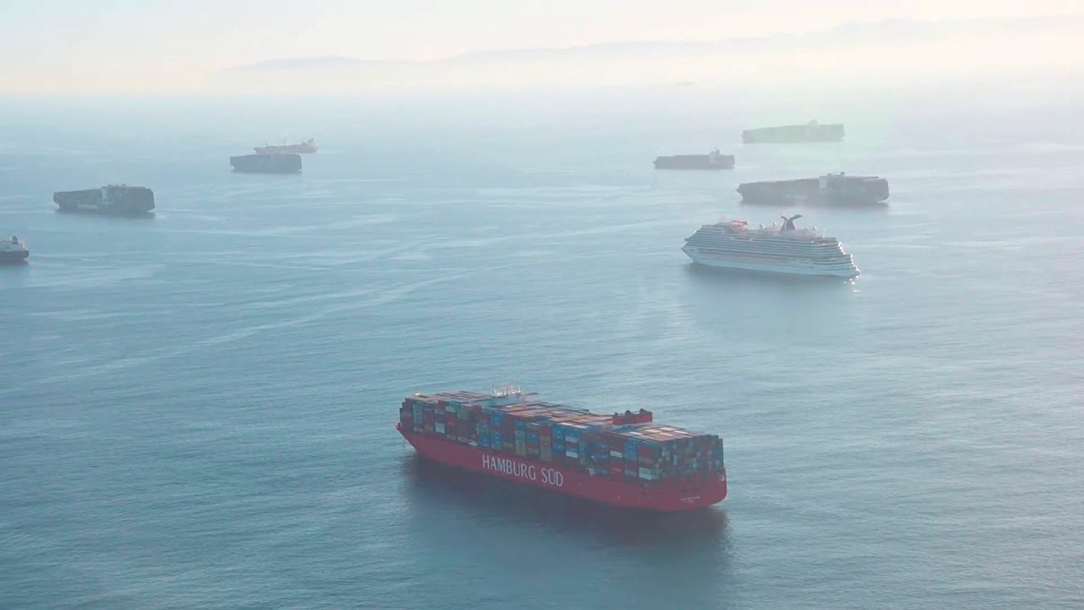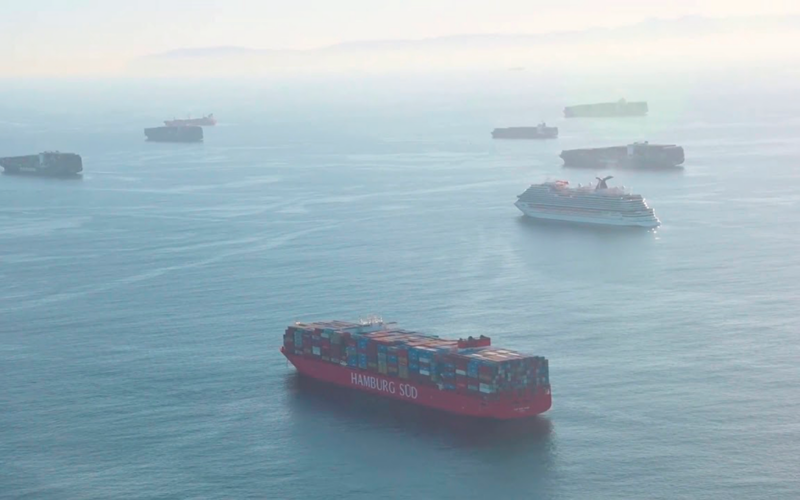
The National Transportation Safety Board (NTSB) has found that a 2021 oil spill in San Pedro Bay, Ca., which cost $160 million to clean up stemmed from two cargo ships that, nine months earlier, dragged their anchors over a major oil pipeline.
On January 25, 2021, MSC Danit and Beijing were anchored in the Bay when a storm struck and both ships dragged anchor over the San Pedro Bay Pipeline, ultimately pulling it up to 105 feet out of position.
According to the NTSB report, those “external forces” caused cracks in the pipeline wall that worsened over time until October 1, 2021, when it ruptured and roughly 588 barrels of oil leaked into the Bay over the next 13 hours and sheening was observed early the next day.
The agency also found that personnel from Beta Offshore, the pipeline operator, had “failed to respond appropriately” to alarms suggesting a leak.
“Had the controllers responded in accordance with company procedure for a leak by shutting down and isolating the pipeline, they would have significantly reduced the volume of crude oil released and the resulting environmental damage,” the report said.
“Although both ships’ anchors struck, damaged, and displaced the pipeline, the MSC Danit anchor’s contact with the San Pedro Bay Pipeline was the initiating event that led to the eventual crude oil release,” the NTSB said.
“Because of the proximity of anchorage positions to the pipeline,” the report continued, “the crews of Beijing and MSC Danit had insufficient time and space to heave in their dragging anchors in high winds and seas before the anchors contacted the pipeline.”
The 1,199-foot, Panama-flagged MSC Danit arrived off Southern California a week before the incident. Its crew dropped anchor at position SF-3 on the southeast edge of Anchorage F and payed out seven 90-foot shots of chain, in 93 feet of water.
The 1,150-foot Maltese-flagged Beijing arrived five days later and anchored in position SF-12, on the southeast edge of a contingency anchoring area located south of Anchorage F. Its crew payed out six shots of chain in 102 feet of water.
The anchor dragging incident occurred during a period of congestion at West Coast ports as dozens of ships loitered, sometimes for weeks, for an open berth. At the time, Anchorage F was nearly full in the morning and its adjacent contingency anchorage area was completely occupied.
The weather worsened at about 3:30 am on January 25 with the wind speed increasing from 15 to 28 knots, with gusts surging to 47 knots and a few minutes later, an alarm on Beijing’s electronic chart display and information system (ECDIS) warned the anchor was dragging with the second officer later confirming the ship was drifting in an easterly direction toward the pipeline.
The master ordered crewmembers to the bow to the anchor and the engineer to ready the main engine for maneuvering.
AIS data reviewed by investigators showed Beijing passed over the San Pedro Bay Pipeline at 4:05 am, the ship’s main engine came online six minutes later, and the ship began maneuvering in and out of Anchorage F for almost five hours. The port anchor remained on the seafloor for much of the day while crew worked to troubleshoot and ultimately replace a failed windlass motor.
“After Beijing had initially passed over the pipeline, it continued to maneuver nearby, with its AIS position passing over the charted location of the pipeline at least 10 times,” according to the NTSB report.
MSC Danit had initially anchored just north of Beijing. AIS data indicates the ship started dragging its anchor at about 5:16 am with the ship maneuvering under its own power just seven minutes later. According to investigators, AIS data further showed the ship crossed the pipeline’s location for the first time at about 5:53 am. The crew had already begun heaving the anchor, hauling in roughly 18 feet of chain per minute.
However, that process was halted at about 6:20 am as another ship, Hong Kong Spirit, drifted toward MSC Danit’s position.
At 7:03 am, “MSC Danit’s forward progress halted, with the ship directly over the pipeline,” the report said. “For the next one hour and eight minutes, the ship’s AIS position remained within an area about 600 feet in radius, centered on the eventual leak location on the pipeline.”
Coast Guard Vessel Traffic Services (VTS) Los Angeles-Long Beach used its monitoring equipment that identifies anchor dragging within the anchorage in real time.
In such situations, the agency said, an audible alarm feature on the VTS vessel monitoring system that sounded when vessels came near a pipeline could raise awareness ahead of potential anchor strikes. But, in this case, the system failed to simultaneously sound an alarm to alert the on-duty watchstanders.
Multiple vessels dragged their anchors around the same time as MSC Danit and Beijing with two anchored ships ultimately colliding and others drifting into anchorages previously occupied by Beijing and MSC Danit, whose master at one point reported a “dangerous situation” developing as Hong Kong Spirit drifted toward its position.
The NTSB acknowledged that Coast Guard VTS watchstanders were overwhelmed early on January 25 as multiple vessels drifted within Anchorage F.
“Exceptionally high vessel activity occurring in the anchorage due to the weather” prevented watchstanders from identifying the risk to the pipeline posed by Beijing and MSC Danit, the report said.
The 17-mile San Pedro Bay Pipeline dates to 1979, when it was built to connect offshore oil drilling platforms with a shoreside facility in Long Beach. It was made from 16-inch-diameter steel and encased in concrete. The pipeline is no longer in operation.
For more than two decades, the pipeline was situated at least 1,500 feet from the eastern edge of Anchorage F.
However, the Coast Guard authorized an expansion of the anchorage in 2006.
Just 786 feet separated the pipeline from where MSC Danit anchored with 933 feet separating Beijing’s anchor and the pipeline.
Investigators removed segments of the pipeline for analysis. They found one section was badly deformed and identified gashes and fatigue cracks that worsened until the pipeline ruptured, the report said.
The San Pedro Bay Pipeline Co. owned the pipeline, while Beta Offshore oversaw its operation. Both are subsidiaries of Houston-based Amplify Energy Corp.
Prior to the release of NTSB’s report, the Coast Guard conducted a holistic risk assessment of established anchorage grounds.
As a result of the risk assessment, the Coast Guard initiated the process to increase the distance between Anchorage Ground F in the San Pedro Bay anchorage ground and the pipeline.
The Coast Guard also increased the distances between anchorages within Anchorage Ground F to give vessels more room to maneuver and anchor.

